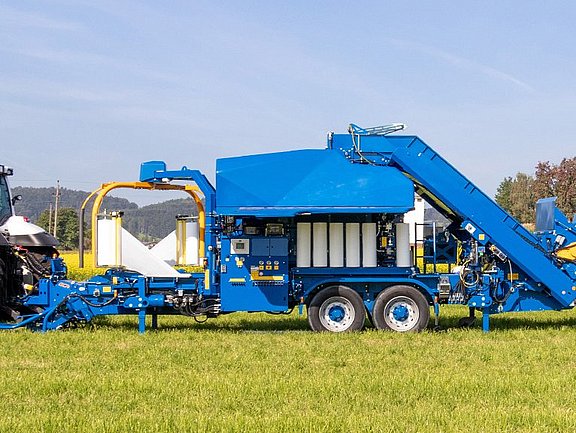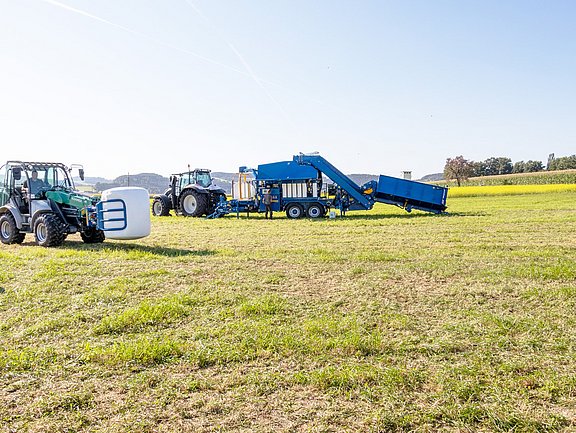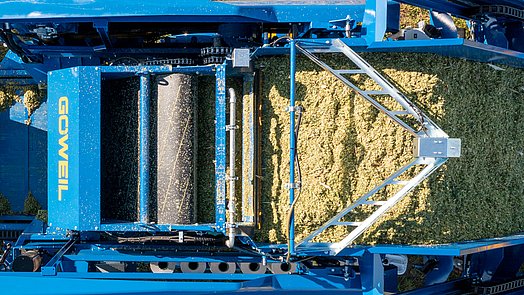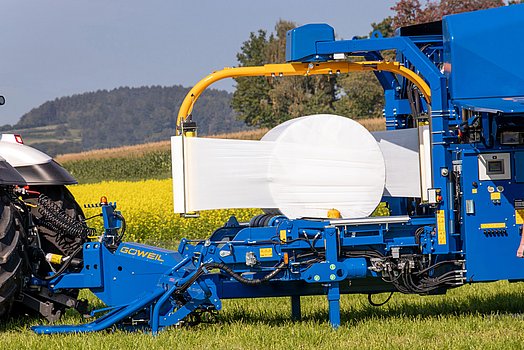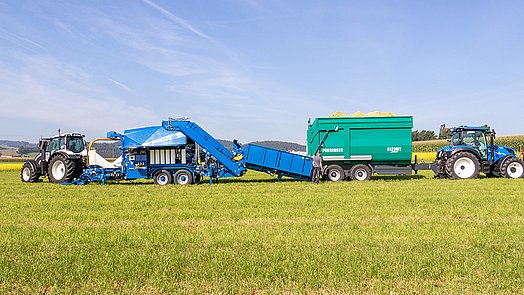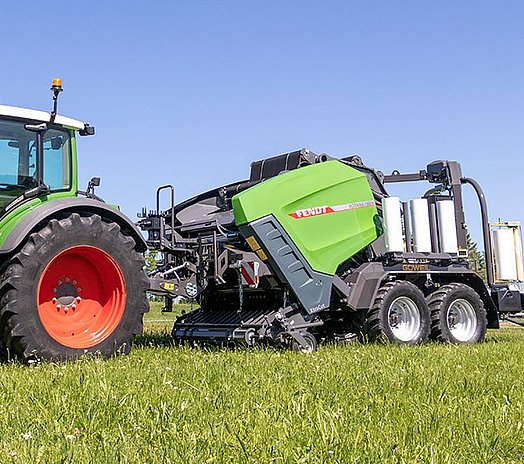Silage baler
LT-Master F115 | Baler-wrapper combination
The LT-Master is the number one baler-wrapper combination for round bales. It can be used to process not only corn silage, but also CCM, alfalfa, hemp, sugar beet pulp, grain, compound feed, and many other materials, into perfectly compressed and wrapped round bales. Fast, simple, and fully automatic.
Every last detail contributes to an optimum material flow, ensuring that the LT-Master F115 delivers top-class throughput performance. The high compression of the feed is top priority along with a rapid air-tight seal and a clean production process. Compaction rates of between 30% and 70% can be achieved depending on the size and structure of the material.
The new LT-Master F115
With the LT-Master F115, GÖWEIL is presenting an overhauled model of the tried-and-tested baler-wrapper combination. In addition to the state-of-the-art design, the silage baler impresses with a range of innovations that offer operators greater convenience and flexibility when using the machine.
Hydraulically powered bale chamber
Unlike the predecessor model, the bale chamber of the LT-Master F115 is powered hydraulically rather than mechanically. During the baling and binding process, it is now also possible to choose between four different speed levels.
Multicrop feeder
In order to better process the many different materials, the feeder has been equipped with a dosing drum.
PROFI plus L terminal
The LT-Master F115 is operated with the PROFI plus L terminal. The user interface is structured intuitively and enables easy operation of the machine.
General highlights of the LT-Master F115

The pivoting drawbar can swivel up to 30° on either side. This provides a tight turning radius and allows the machine to be powered from either side.

A dual-line air brake system is fitted as standard.
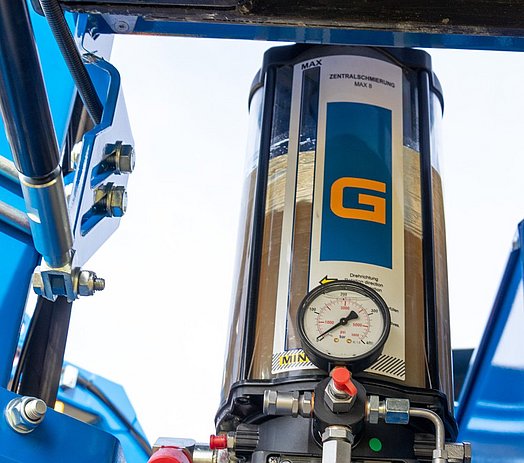
The central lubrication continuously supplies the main lubrication points with grease and oil. This ensures a very long service life and minimal wear and tear.

Thanks to the hydraulically folding film storage holding up to 18 rolls of film, the LT-Master is ideally suited to long workdays.

As a result of the 80 km/h chassis all work sites can be reached quickly, no matter whether this is with the tractor or truck. The LT-Master F115 has an EU type-approval.

The LED work lights provide the LT-Master with perfect illumination, even when it is used at night.
To activate YouTube please click on the button. By activating embedded videos, data is transmitted to Google. Further information can be found in our privacy policy.
Feeding system & dosing highlights
Low-profile design
The low profile design and 3.50 meter width of the feeder make the filling process quick and easy—whether you use a dump trailer, push-off trailer, truck, or direct feeding.
Scraper floor
The speed of the scraper floor adapts to the quantity of material and is automatically self-regulating. The galvanized, die-forged scraper floor chains from Rübig used on the elevator and feeder are indestructible.
Large-capacity Multicrop feeder:
The Multicrop feeder provides a large buffer with a volume of around 13 m³. This large capacity keeps the LT-Master F115 running during feeding.<br/> In order to better process the many different materials, the feeder has been equipped with a dosing drum. This and the feed screws ensure an even flow of materials onto the elevator and also optimally process fibrous material such as grass and alfalfa.
Baler highlights
Hydraulically powered bale chamber
The hydraulically powered bale chamber favors a machine-friendlier way of working and also reduces the noise level of the baler-wrapper combination. What's more, the hydraulic drive enables the user to choose between different speeds during baling and binding (4 levels respectively). This means that the machine can be better adapted to the different materials and conditions, saving time and energy.
Fixed roller chamber
The two halves of the bale chamber are surrounded by a bale chamber belt, thereby minimizing loss of material. The belt tension can be adjusted hydraulically, helping to ensure a reliable bale start and good bale ejection.
High bale density
The 4 mm thick steel rolls are reinforced on the inside; the ribbing ensures optimal bale density and secure rotation of the bale.
Long service life
Large, sealed bearings and a perfectly adapted lubrication system guarantee a long machine service life.
Net or film
An efficient binding system is needed to keep a bale in perfect condition. The LT-Master F115 is equipped as standard with a combined dual binding unit for net and film.
Refeed belt
The refeed belt running underneath the entire length of the machine prevents loss of material; stray material that escapes during the baling process is caught and fed back into the elevator without getting dirty.
Variable bale size
This setting allows a stepless bale size setting from 0.60–1.15 m.
Water spray
Adds water to dry materials during baling.
Wrapper highlights
Mobile wrapping table
The wrapping table slides under the bale chamber and picks up the bales directly, quickly, and gently.
Twin wrapping arm
The wrapper always stays one step ahead thanks to its standard twin wrapping arm including 2 x 750 mm film pre-stretchers. The patented plastic rollers mean more bales per roll of film.
Film cutter
The stainless steel cutting knife guarantees precise cutting of the film. The standard float position of the film cutter ensures easy release of the film, which means that no remnants are trapped.
Bale delivery ramp
The hydraulically lowerable bale delivery ramp ensures a gentle bale deposit.
Film monitoring and single-film mode
If a roll of film runs out or the film tears, the feed rate of the wrapping table is reduced until a 50% overlap is guaranteed once more.<br/> This allows bale wrapping to be completed without interruption. If both film rolls run out or tear, the film monitoring stops the wrapping process.
Control system
Program control PROFI with PROFI plus handset
The LT-Master F115 is operated with the PROFI plus L terminal. The user interface is structured intuitively and enables easy operation of the machine. The entire work process as well as the machine settings are depicted via the display. Via the terminal's USB port, the language and customer logos for the weighing system with label printer can be imported with ease and customer account data exported in CSV format.
Materials suitable for baling
The large variety of materials suitable for baling and wrapping means that the LT-Master F115 can be used for a wide range of purposes. As a result of the various harvest times, the machine can be used to capacity all year round. This guarantees maximum efficiency and utilization. The most common materials at a glance:
Corn silage is produced using the entire corn plant and serves as one of the most important staple feeds for livestock with high milk yields. Corn silage provides particularly nutritious energy in the form of starch from crushed corn grains and is also very rich in fiber. In this way, corn silage provides the optimal conditions for achieving maximum milk or fattening yields. Particularly at temperatures above 15 degrees Celsius, the feed can deteriorate in quality due to the high activity of microbacteria. The very high compression during the LT-Master F115 baling process achieves unmatched keeping and feed quality.
CCM (corn-cob-mix) is an excellent energy feed made from the cob and kernels of the corn cob. It is used to feed pigs, cattle, and other small ruminants. CCM silage offers the maximum energy concentration through additional starch and has an excellent price-performance ratio in comparison with traditional concentrated feed.
The crushing of corn grains gives the feed more structure and makes it very easy for livestock to pick up. Due to their compact shape, CCM silage bales are perfectly easy to handle and also ideally suited to feeding in smaller quantities.
Alongside corn silage, alfalfa silage is one of the most important basic feed components in cattle feeding. High feed intake as well as particularly high structural effectiveness contributes to substantial cattle milk yields. The cultivation of alfalfa offers high yield security and also improves the quality of the soil. However, its low sugar content makes alfalfa very difficult to preserve using traditional methods. Processing into round bales using an LT-Master F115 significantly enhances the silage quality of alfalfa thanks to the rapid air-tight seal and effective compression.
Pressed sugar beet pulp silages are characterized by a very high energy content, they are easily digestible, and impress with their palatability. They are an ideal supplement to grass silages since they have a negative ruminal nitrogen balance and thereby compensate for the protein balance in the stomach. Pressed beet pulp silages have very low lactic acid content and therefore also a very low total acidity. High compression as well as clean processing while still warm are hugely important for silage quality. LT-Master F115 round bales also cool down faster and can therefore be used for feeding sooner.
A TMR contains a balanced mix of staple forage and concentrated feed. Dry matter content and energy content are perfectly coordinated. TM rations have a very positive effect on milk yields and animal health. Previously fermented silages are mixed and ensiled again for stockpiling TMR. The LT-Master F115 can be used to produce TMR inventory quickly, easily, and inexpensively. It is transportable and therefore an ideal solution for trade.
Be it wood shavings, wood wool, bark mulch, wood chips, or pellets, the LT-Master F115 can be used to press all materials into compact bales. This makes transport easier and also saves on expensive storage locations. The bales can be transported with a tractor, stacked, or loaded onto a pallet. Pressed into a bale, the material stays clean and dry.
Cereal grain whole plant silages tend to be produced using barley, wheat, or triticale. Cultivation provides a very reliable yield and has benefits in the field of crop management. However, cereal grains have a very low energy content and is difficult to ensile using traditional methods. Optimal compression and the rapid air-tight seal make it easy to produce cereal grain silage with the LT-Master F115.
Grass silage serves as the most important staple forage for livestock. The feed is made from an optimal combination of sweet grasses, herbs, and clover.
Grass types with a high sugar content guarantee a good fermentation process. Thanks to the LT-Master F115, even grasses with a higher fiber content can be optimally processed due to the high bale density.
The storage of garbage and waste is an ever-growing problem. Some materials are prepared for further processing and used as substitute fuels. The LT-Master F115 offers a quick and easy solution to the associated storage and transport problems. Compressed bales can be transported compactly and are ideally suited to temporary storage. In principle, solid residues such as plastic, domestic refuse, shredded carpet, and even compost can be processed into round bales.
Industrial hemp is characterized by a very high CBD content and is primarily used in the pharmaceutical and cosmetics industry.
Wild animal feed, vegetable waste, sugar cane, crushed corn, horse manure, apple pomace, straw, etc.
Setup & preparation
One significant highlight of the LT-Master F115 is the short setup time of around three minutes. This is particularly important when it comes to the professional applications of contractors, who sometimes change locationmultiple times a day. The machine is set up completely hydraulically. The LT-Master F115 is ready for use in just a few simple steps.
Preparing the machine
Other time-eaters can also be taken care of quickly and easily thanks to optimized detailed solutions:
- Thanks to the quick-release fastener, the wrapping film can be replaced in a very short time.
- It is possible to change between a net and wide film in just a few simple steps.
- Thanks to the program control "PROFI" and the PROFI plus L terminal, the machine can be optimally matched to the material. A real benefit: the new graphical and intuitive control system interface
- Grease (8 l) and oil (16 l) can be topped up in the central lubrication with ease.





Basic model
WITH EU type-approval for up to 80 km/h
The LT-Master F115 is equipped as standard with a combined dual binding unit. As a result, two rolls of net or film can be inserted at the same time or even in combination.
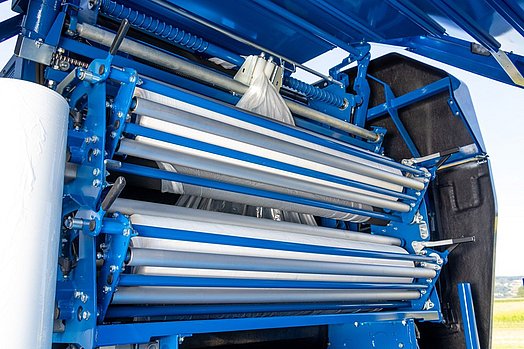
Working width 3.50 m
Always correctly dosed! This setting can be used to optimally adapt the round bales to the required feed quantity. The bale size can be varied continuously between 0.60 and 1.15 m.
only for film binding


The camera system, which is equipped with four infrared cameras, provides a perfect overview of the entire workflow and the area around the machine – both day and night.
The four cameras are positioned so as to allow a clear view of the top of the bale chamber, the elevator, the wrapping table, and the rear of the machine (on the right in the direction of travel).
The correct dry and moisture content of the material is crucial for high compression of the material and perfectly compressed bales. In the case of very dry materials, water can be added directly to the bale chamber via the water injection unit.<br/>
Consists of a solenoid valve, tubing, and adjustable nozzles.

The compact remote control works via radio transmission and initiates bale deposit of the wrapped bale. Thanks to its handiness, the user can keep the transmitter with them at all times and start the deposit.

All work cycles are fully automatic
Technical data (basic model)
| Weight: | 14,800 kg | |
| Length: | 11,850 mm | |
| Width: | 2,550 mm | |
| Height: | 4,000 mm | |
| Bale diameter: | from 0.60 to 1.15 m | |
Tractor power requirements | ||
| Oil requirement pivoting drawbar: | 10 l at 200 bar | |
| Power requirements: | At least 90 kW | |
Required connections
Connections for operation |
| Cardan shaft connection: Speed: 740 -1000 | 1 3/8" Z6 or 1 3/8" Z21 |
| 1 double-acting and 1 single-acting control device for the pivoting drawbar |
| Power is supplied to the machine via the ISOBUS socket or the cable harness supplied. |
Connection for electric motor: 400 V/50 Hz, CEE 125 A, 740 rpm, protection class IP55 |
Brake connections |
| Connections for dual-line air brake system or |
| Connections for the hydraulic dual-line brake system |
Transport connections |
| A 7-pin socket for the entire lighting system, except work lights |
| Adapter for trucks: 24V | 7-pin | 15-pin (optional) |
| ABS |
Additional equipment
The drive works using a joint shaft, which also makes it possible to use a tractor at any time. The engine is very quiet and operating costs are kept down in comparison with a tractor with high fuel costs. As a result, not only do you save space, but also exhaust gases, thereby enabling operation in sheds. However, the cover makes it possible to use the electric drive outdoors with ease too (temperature range: -15 to +60°C). The maintenance costs are very low and thanks to the base with forklift slings, the electric drive is easy to transport. The electric drive has a soft starter. This massively reduces initial voltage peaks as well as the starting torque. This also saves power and is gentle on the drive, shafts, and transmission.
| Power: 90 kW | Voltage: 400 V | Frequency: 50 Hz |
| Protection class: IP 55 | Power consumption: max. 125A | Drive: 740 rpm |
| Weight: 2,970 kg | L x W x H: 1,773 x 1,323 x 1,652 mm | CEE 125A |

Consisting of weighing table, weighing terminal, and label printer with GÖWEIL logo or customer logo
The four weighing cells are directly integrated into the wrapping table. The display is attached to the switch panel. The weighing process for the wrapped bales runs automatically, ensuring that there are no time delays in the workflow. The bales can be weighed individually or even analyzed as a complete batch. The various options can be set very easily via the terminal. The label printer depicts information such as the bale weight, date, time, and a loaded logo. If no labels are required, this function can be switched off on the terminal. Adhesive labels and labeling strips are standard products and available from specialist stores. The weighing system can be retrofitted on existing machines.
Consisting of weighing table, weighing terminal, and label printer with GÖWEIL logo or customer logo
The four weighing cells are directly integrated into the wrapping table. The display is attached to the switch panel. The weighing process for the wrapped bales runs automatically, ensuring that there are no time delays in the workflow. The bales can be weighed individually or even analyzed as a complete batch. The various options can be set very easily via the terminal. The label printer depicts information such as the bale weight, date, time, and a loaded logo. If no labels are required, this function can be switched off on the terminal. Adhesive labels and labeling strips are standard products and available from specialist stores. The weighing system can be retrofitted on existing machines.
Thanks to the bale tipper integrated in the bale delivery ramp, it is possible to gently deposit the bale on the left or right. If this is deactivated, the bale is rolled off to the front as standard. Storage of the bales on their ends enables quicker and gentler removal.

In order to achieve a good ensiling result, there are a few key factors:
- The ensiling suitability of the material
- Adherence to the ensiling rules (harvest time and wilting, cutting length, efficiency of the silage chain, compression, and air-tight seal)
- Weather conditions
If not all factors are perfectly coordinated (e.g., due to periods of bad weather), silage additives should help to significantly improve the ensiling result by preventing incorrect fermentation and subsequent warming processes.
Using a self-priming pump with filter and electronic flow meter, the silage additive is injected directly into the bale chamber via two stainless steel nozzles. The silage additive is thereby optimally distributed in the feed of the round bales. The dosing unit is ideal both for lactic acid bacteria and low-corrosion acids.
Note: tank not included.
Important: After use, the silage additive dosing must be rinsed with water every day.
Scope of delivery:
- Dosistar control unit
- Pump with filter
- Electronic flow measurement
- Various nozzles
- Suction hose for external containers


The 450-liter stainless steel tank is mounted directly on the machine and ensures complete discharging.
12V to 24V
Consisting of spiral cable with 15-pin to 13-pin and 2x 7-pin to 13-pin
Customers can choose from a large selection of drawbar eye types
Country-specific equipment
WITHOUT EU type-approval
FAQ
Frequently asked questions
The LT-Master can be used to process not only corn silage, but also CCM, alfalfa, hemp, sugar beet pulp, grain, compound feed, and lots of other materials, into perfectly compressed and wrapped round bales.
The weight depends on the bale size and on the dry mass content of the material.
The tractor must have at least 120 HP (90 kW) and needs the following connections:
1. 1 double-acting and 1 single-acting control device for the pivoting drawbar.
2. Power is supplied to the machine via the cable harness supplied.
3. 7-pin socket for the entire lighting system, except work lights.
4. Connection for electric motor: 400 V/50 Hz, CEE 125 A, 740 rpm, protection class IP55
Oil requirement pivoting drawbar: 10 l at 200 bar
The number of bales produced in an hour may depend on the material.
